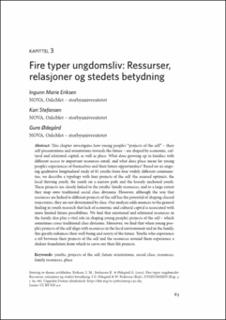| dc.contributor.author | Eriksen, Ingunn Marie | |
| dc.contributor.author | Stefansen, Kari | |
| dc.contributor.author | Ødegård, Guro | |
| dc.date.accessioned | 2022-01-21T08:56:09Z | |
| dc.date.available | 2022-01-21T08:56:09Z | |
| dc.date.created | 2021-11-20T11:50:36Z | |
| dc.date.issued | 2021-11-18 | |
| dc.identifier.isbn | 978-82-02-73299-8 | |
| dc.identifier.uri | https://hdl.handle.net/11250/2838598 | |
| dc.description.abstract | This chapter investigates how young people’s “projects of the self” – their self-presentations and orientations towards the future – are shaped by economic, cultural and relational capital, as well as place. What does growing up in families with different access to important resources entail, and what does place mean for young people’s experiences of themselves and their future opportunities? Based on an ongoing qualitative longitudinal study of 81 youths from four widely different communities, we describe a typology with four projects of the self: the assured optimist, the local thriving youth, the youth on a narrow path and the loosely anchored youth. These projects are closely linked to the youths’ family resources, and to a large extent they map onto traditional social class divisions. However, although the way that resources are linked to different projects of the self has the potential of shaping classed trajectories, they are not determined by class. Our analysis adds nuances to the general finding in youth research that lack of economic and cultural capital is associated with more limited future possibilities. We find that emotional and relational resources in the family also play a vital role in shaping young people’s projects of the self – which sometimes cross traditional class divisions. Moreover, we find that when young people’s projects of the self align with resources in the local environment and in the family, this greatly enhances their well-being and surety of the future. Youths who experience a rift between their projects of the self and the resources around them experience a shakier foundation from which to carve out their life projects. | en_US |
| dc.language.iso | nob | en_US |
| dc.publisher | Cappelen Damm Akademisk | en_US |
| dc.relation.ispartof | UNGDOMMEN | |
| dc.rights | Attribution-NoDerivatives 4.0 Internasjonal | * |
| dc.rights.uri | http://creativecommons.org/licenses/by-nd/4.0/deed.no | * |
| dc.subject | Youths | en_US |
| dc.subject | Projects of the self | en_US |
| dc.subject | Future orientations | en_US |
| dc.subject | Social classes | en_US |
| dc.subject | Resources | en_US |
| dc.subject | Family resources | en_US |
| dc.subject | Places | en_US |
| dc.title | Fire typer ungdomsliv: Ressurser, relasjoner og stedets betydning | en_US |
| dc.type | Chapter | en_US |
| dc.type | Peer reviewed | en_US |
| dc.description.version | publishedVersion | en_US |
| dc.rights.holder | © Ingunn Marie Eriksen, Kari Stefansen, Guro Ødegård | en_US |
| cristin.ispublished | true | |
| cristin.fulltext | original | |
| cristin.qualitycode | 1 | |
| dc.identifier.doi | https://doi.org/10.23865/noasp.142 | |
| dc.identifier.cristin | 1956781 | |
| dc.source.pagenumber | 63-86 | en_US |

